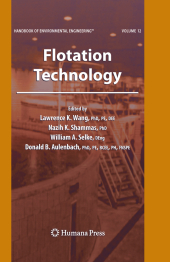 Neuerscheinungen 2016Stand: 2020-02-01 |
Schnellsuche
ISBN/Stichwort/Autor
|
Herderstraße 10
10625 Berlin
Tel.: 030 315 714 16
Fax 030 315 714 14
info@buchspektrum.de |

Donald B. Aulenbach, William A. Selke, Nazih K. Shammas, Lawrence K. Wang
(Beteiligte)
Flotation Technology
Volume 12
Herausgegeben von Wang, Lawrence K.; Shammas, Nazih K.; Selke, William A.; Aulenbach, Donald B.
Softcover reprint of the original 1st ed. 2010. 2016. xxi, 680 S. 216 Tabellen. 254 mm
Verlag/Jahr: SPRINGER, BERLIN; HUMANA PRESS 2016
ISBN: 1-493-95670-1 (1493956701)
Neue ISBN: 978-1-493-95670-8 (9781493956708)
Preis und Lieferzeit: Bitte klicken
The past 30 years have seen the emergence of a growing desire worldwide that positive actions be taken to restore and protect the environment from the degrading effects of all forms of pollution - air, water, soil, and noise. Since pollution is a direct or indirect consequence of waste, the seemingly idealistic demand for "zero discharge" can be construed as an unreal- tic demand for zero waste. However, as long as waste continues to exist, we can only attempt to abate the subsequent pollution by converting it to a less noxious form. Three major questions usually arise when a particular type of pollution has been identi?ed: (1) How serious is the pollution? (2) Is the technology to abate it available? and (3) Do the costs of abatement justify the degree of abatement achieved? This book is one of the volumes of the Handbook of Environmental Engineering series. The principal intention of this series is to help readers formulate answers to the last two questions above. The traditional approach of applying tried-and-true solutions to speci?c pollution p- blems has been a major contributing factor to the success of environmental engineering and has accounted in large measure for the establishment of a "methodology of pollution control. " However, the realization of the ever-increasing complexity and interrelated nature of current environmental problems renders it imperative that intelligent planning of pollution abatement systems be undertaken.
FLOTATION TECHNOLOGY TABLE OF CONTENTS PREFACE CONTRIBUTORS PRINCIPLES OF AIR FLOTATION TECHNOLOGY Nazih K. Shammas and Gary F. Bannett GAS DISSOLUTION, RELEASE AND BUBBLE FORMATION IN FLOTATION SYSTEMS Lawrence K. Wang, Nazih K. Shammas, William A. Selke, and Donald B. Aulenbach SEPARATION OF OIL FROM WASTEWATER BY AIR FLOTATION Gary F. Bannett and Nazih K. Shammas FUNDAMENTALS OF WASTEWATER FLOTATION Nazih K. Shammas, Lawrence K. Wang and Herman H. Hahn ELECTROFLOTATION Lawrence K. Wang, Nazih K. Shammas and Betty C. Wu WASTEWATER TREATMENT BY ELECTROCOAGULATION-FLOTATION Nazih K. Shammas, Alain Grasmick and M.F. Pouet TREATMENT OF PAPER MILL WHITEWATER, RECYCLING AND RECOVERY OF RAW MATERIALS Nazih K. Shammas, Lawrence K. Wang and Mark Landin OZONE-OXYGEN OXIDATION FLOTATION Lawrence K. Wang and Nazih K. Shammas WASTEWATER RENOVATION BY FLOTATION Nazih K. Shammas FLOTATION-FILTRATION SYSTEM FOR WASTEWATER REUSE Nazih K. Shammas ALGAE REMOVAL BY FLOTATION Donald B. Aulenbach, Nazih K. Shammas, Lawrence K. Wang and Rodney C. Marvin COMPLETELY CLOSED WATER SYSTEMS IN PAPER MILLS Nazih K. Shammas, Lawrence K. Wang and William A, Selke LAKE RESTORATION USING DAF Donald B. Aulenbach, Nazih K. Shammas, Lawrence K. Wang and R. Derrick I. Kittler JIMINY PEAK, HANCOCK, MASSACHUSETTS WASTEWATER TREATMENT PLANT: THE FIRST RBC-DAF-UV WWTP IN US Lawrence K. Wang, Donald B. Aulenbach and James P. Van Dyke PITTSFIELD WATER TREATMENT PLANT: ONCE THE WORLD´S LARGEST FLOTATION- FILTRATION PLANT Lawrence K. Wang, Nazih K. Shammas, Donald B. Aulenbach, William A. Selke and Daniel B. Guss PRETREATMENT OF MEAT PROCESSING WASTE Nazih K. Shammas, Jaceck Wasowski, Lawrence K. Wang and William A. Selke TREATMENT OF SEAFOOD PROCESSING WASTEWATER Lawrence K. Wang, Donald B. Aulenbach and Nazih K. Shammas LABORATORY SIMULATION AND TESTING OF AIR FLOTATION AND ASSOCIATED PROCESSES Nazih K. Shammas, Lawrence K. Wang, William A. Selke, and Donald B. Aulenbach Appendix: CONVERSION FACTORS FOR ENVIRONMENTAL ENGINEERS


